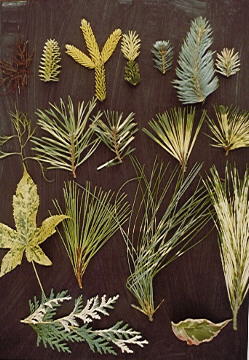
Why Conifers Weep
The actual cause of a weeping growth habit is not entirely understood. It appears to be partly related to an uneven distribution of growth auxins in the plant’s growing shoots. Gravity commonly causes an auxin distribution that accelerates cells’ growth along the basal (bottom) side of a shoot and retards the growth along its dorsal (top) side, causing it to grow up and away from the ground. This auxin distribution leads to the formation of the compression wood on the basal side of a branch. In a vertical shoot, there is no auxin difference and no compression wood formation.
An acceleration of cambial activity forms compression wood. It is up to 40% heavier than normal wood since it is rich in lignin (up to 40%) and lower in cellulose (32% vs. 42%). Compression wood has a red color and different expansion properties than normal wood. The cells in newly formed compression wood expand longitudinally and try to push the branch upward, resulting in additional force to keep the branch from turning down. Likewise, if a tree is harvested and milled and has compression wood present (perhaps due to leaning), there is more shrinkage of the compression wood section of any lumber produced, causing warpage.
Compression wood is denser and darker in color, making it challenging to separate summer wood from spring wood. In a branch’s cross-section, the compression wood has wider growth rings than wood, leading to an oval cross-section—the greater the branch’s weight, the greater the volume of compression wood produced. Pendulous conifers with many trunks or thick branches that are not vertical have an oval cross-section to those parts.
According to Gerald Kingman, University of Arkansas, plants weep due to lignin’s cell walls actions. Lignin gives rigidity and strength to cells and is a critical component of wood. If it forms later than expected in a plant, gravity can pull a branch down before it hardens. Once it hardens, the branch is locked in that weeping position, and to try and bring it back up can break the branch.
In the spring, when the growth auxin/gravity interaction occurs, a conifer’s new growth “reaches up to the sky.” This activity can even cause weeping branches to be “pulled upward,” and the spring wood is forming. The upward growth can cause bending beyond the vertical, corrected by the auxins, resulting in a slow-motion, waving action of the new shoot. As the new growth slows and hardening occurs, lignin stabilizes the shoot. If the lignin does not form and harden, the shoot bends due to gravity’s pull. Then it hardens in a pendulous position. If the shoot is staked, it hardens in the vertical position and stays that way. If the pendulous conifer maintains a solid central leader on its own, lignin must first form and harden in that area.
This mutation may be encouraged in regions with heavy snowfall. Plants with weak lateral branches have the best chance of survival since they bend relatively easily under heavy snow loads. A weak lateral branch would be shaded by stronger growing branches and die in regions without heavy snowfall.
It is interesting to note a seasonal effect upon the tendency of conifers to weep. I had not noticed this until Al Fordham visited me when I lived in Pennsylvania. We observed that the newly elongated candles on a Pinus strobus f. pendula were all standing straight up, often to the extent that they curved up beyond the vertical. Even the previous year’s growth, consisting of well-hardened wood, had been pulled up and extended horizontally.
Wood formed in spring on this cultivar exhibits “normal” growth. The new candles or shoots point straight up, and auxin activity causes the older wood to follow suit as it forms new wood. As the wood hardens and the branches thicken during the summer, the shoots turn down, producing a weeping conifer. I have noticed this effect on many pines. The pendulous spruces don’t appear to do the same, perhaps because the new shoots are not as strong as pine.
Auxins can rapidly bend old wood in the spring. I once laid a Picea glauca ‘Conica’ on its side when spring growth was at its maximum. In a few days, the tree started to bend toward the sky. As the new growth hardened off, I stood the tree upright, and the trunk bent at a 90o angle.
Hanging a pine upside down when the new growth begins causes a 180o bend in the trunk in a little over a week, and repeated turning could produce a corkscrew effect in the trunk.
Many conifer species have weeping forms. A number of these weepers produce viable seeds, which often produce seedlings with different weeping habits. For example, the spruce Picea omorika f. pendula varies from species normal to a narrow spire. Another spruce, Picea abies f. pendula, can be one of several named cultivars: ‘Reflexa’, ‘Inversa’, ‘Aarburg’, or ‘Waartburg’. But the most prolific species of all is Tsuga canadensis. People have been growing seedlings of weeping forms of this species since the late 1800s. They have all been lumped together as ‘Pendula’. However, weeping forms found in the wild or gardens with specific names have distinctive growth habits.
| Home Page |
 |
| Conifer Bibliography | |
| Propagation Bibliography | |
| DVD | |
| Product List | |
| Our Story | |
| Plant Site Links |